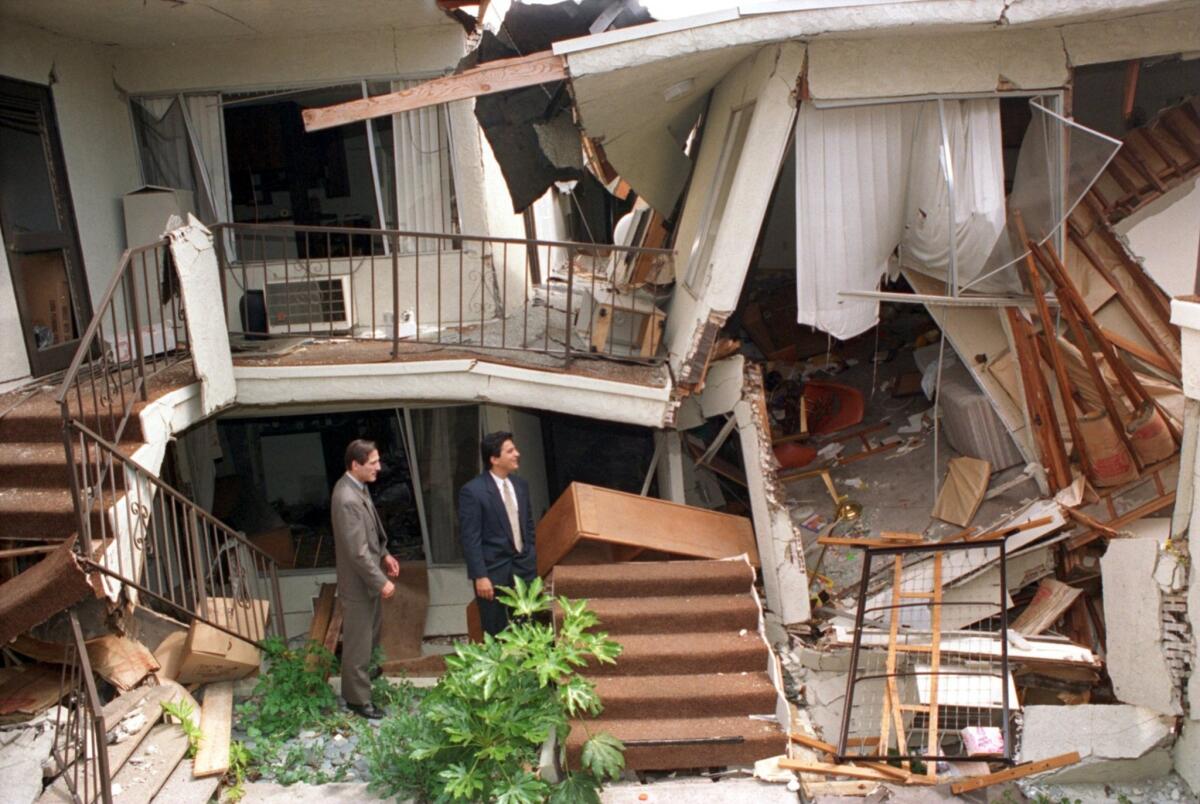Proposed tax credit for quake retrofits runs into trouble in Sacramento

Damage in Sherman Oaks from the 1994 Northridge earthquake is shown. The deadly quake registered a magnitude 6.7.
- Share via
A proposed state tax credit to ease the burden of seismically retrofitting vulnerable buildings failed to make it out of a key committee in Sacramento this week, calling its prospects into question.
Senators on the Legislature’s Conference Committee, which reconciles Assembly and Senate budget proposals, chose not to include the earthquake retrofit tax credit in the budget they will send to the governor, said Dan Savage, chief of staff to Assemblyman Adrin Nazarian (D-Sherman Oaks), who introduced the legislation.
State Sen. Mark Leno (D-San Francisco), who chairs the Senate conference committee, declined to comment on the decision.
Nazarian’s proposal would give property owners a 30% tax break on the cost of the seismic retrofitting.
His staff insisted that, despite the setback, the proposal is not dead.
The Assembly version of the tax break proposal, AB 428, passed last week, 78 to 0.
To reach a vote in the Senate, it would need to get through the Senate’s governance and finance committee, chaired by Sen. Bob Hertzberg (D-Van Nuys), and then the appropriations committee, chaired by Sen. Ricardo Lara (D-Bell Gardens).
Nazarian said he plans to keep fighting.
“We’re protecting life,” he said. “We’re helping strengthen property, and third, we’re actually helping incentivize at least a modicum amount of job growth in the building industry.”
The tax credit idea has been endorsed by the mayors of Los Angeles, San Francisco, Oakland, Berkeley and Santa Monica. In Los Angeles, Mayor Eric Garcetti has proposed new city rules that would require the retrofits of thousands of concrete and wooden buildings.
“The physical threat of death or injury from vulnerable buildings is real,” the five mayors wrote to Leno, who chairs the Senate Budget Committee.
Many apartments in Los Angeles are in “soft story buildings” -- wood-frame structures that have flimsy columns atop carports on the ground story. These weak supports have collapsed in previous earthquakes, killing residents on the bottom floor.
Under the bill, the tax credit would be given to an owner over five years after the retrofitting was completed. For every $100 the owner spent on a qualified retrofitting, he or she would receive a $30 break on income or corporations taxes.
Work eligible for the tax break would include retrofitting wood-frame apartment buildings and concrete residential buildings, installing automatic gas shut-off valves, anchoring single-family homes to foundations and installing quake-resistant bracing systems for mobile homes.
The tax credit would be in effect from 2016 through 2020.
Nazarian has also separately asked budget negotiators to expand a program that gives California homeowners grants of up to $3,000 to seismically retrofit single-family homes.
The Legislature’s Conference Committee approved a $3-million-a-year increase for two years.
The program, called “Brace and Bolt,” is expected to spend nearly $2 million on grants that would help pay for 650 homes to be retrofitted this year. The program is available in 28 ZIP Codes in the San Francisco and Los Angeles areas, and there are plans to expand into additional areas.
Single-family homes built before 1979 that have a handful of above-ground steps sometimes are not bolted to their foundations. Unbolted, they can slide off their foundations during quakes.
For more news on earthquake safety, follow @ronlin and @RosannaXia on Twitter.
More to Read
Sign up for Essential California
The most important California stories and recommendations in your inbox every morning.
You may occasionally receive promotional content from the Los Angeles Times.















